Rescued from Mount Sinjar
A survivor of a deadly helicopter crash recounts efforts by Kurdish Peshmerga, Iraqi Army U.S. Special Forces, and Syrian YPG fighters to save civilians from ISIS militants and starvation.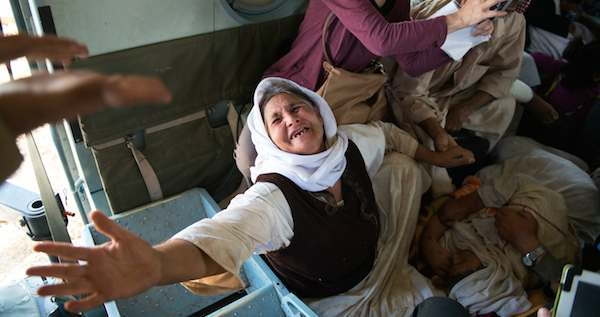
ERBIL - Adam Mirani flew to Mount Sinjar on a mission that was supposed to be quick and straightforward: drop off food and water for some of the thousands of refugees stranded there, and return to Iraqi Kurdistan.
In the ensuing day and a half, however, Mirani would not only survive a deadly helicopter crash, but he would also meet some of the American Special Forces soldiers - as well as Syrian Kurdish militants from the People's Protection Units (YPG) - who were helping a handful of Kurdish Peshmerga soldiers protect civilians from the radical Islamist militants surrounding the mountain.
Mirani's Kurdish-Canadian family had helped provide a cargo of high-energy biscuits, dates, bread, and water, which were loaded onto an Iraqi Army helicopter bound for Mount Sinjar on Aug. 12. Mirani was one of the 14 people on board who flew out to distribute the supplies to members of Iraq's Yezidi minority, dozens of whom had already died of dehydration and hunger.
Two weeks ago, hundreds of thousands of Yezidis fled from the nearby city of Sinjar and other towns, after extremist militants from the so-called Islamic State (formerly the Islamic State of Iraq and al-Sham, or ISIS) launched an offensive in northern Iraq and seized several cities from Kurdish security forces. The offensive was so swift and deadly that it prompted U.S. President Barack Obama to authorize air strikes against ISIS fighters threatening Iraq's major cities and Yezidi refugees.
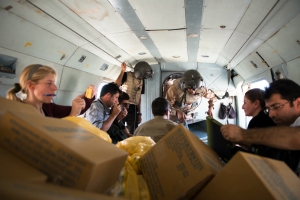
Pilots, journalists, and aid workers board a helicopter bound for Mount Sinjar on Aug. 12, 2014. (ADAM MIRANI)
After the helicopter landed, dozens of refugees swarmed around, desperate to be saved from the militants below and the withering desert heat on the mountain. As the humanitarian team unloaded the supplies, refugees climbed aboard, and Mirani estimates a total of between 30 and 40 people were on the helicopter when it was ready to lift off.
"The pilots obviously didn't want this many people on the aircraft, so one of the gunners went to the back and they really had to drag people off the helicopter because they knew there were too many," Mirani said. "Many people were screaming to let them stay. But you cannot hear people screaming because it's so loud."
The added weight made a complicated takeoff even more perilous. The mountain embankments all around made it hard to maneuver, and the threat of ISIS firepower below meant the pilot needed to take off fast. As the helicopter left the ground, it began to buck the pilot's efforts to control it.
"It hit the ground, scraped the bottom and probably took off the tires," Mirani said.
Then the nose of the chopper caught on the ground and the whole thing flipped, like a bicycle hitting only its front brake.
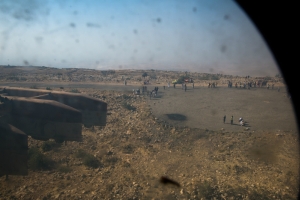
Refugees gather around a landing area awaiting an Iraqi Army helicopter carrying food and water. (ADAM MIRANI)
"We flipped twice, I believe, and landed front side up and on our side," Mirani said. "Everyone inside was thrown to the front of the aircraft, including me."
Next thing he knew, Mirani was caught in a tangle of bodies and limbs. He was being choked by his camera strap, with his camera wedged between several other people. His leg was also caught, and could only be freed after he ripped his pant leg and wriggled his foot from his shoe.
Mirani climbed out the side, hurt and dazed, but able to walk. Others were being pulled out, unable to move on their own. Fuel was pouring from the mangled chopper.
One of the pilots, Maj. Gen. Majid Ahmed Saadi, from Basra, was killed. Almost everyone else was so badly injured that they would soon require an air lift to the hospital in Dohuk - including Vian Dakhil, a Yezidi member of Parliament, and Alissa Rubin, a reporter for The New York Times.
Mirani's ribs ached so badly that he suspected he was suffering internal bleeding. But he was one of the least injured, and stayed behind after the first rescue chopper came for his fellow passengers.
The next rescue helicopter would not be able to land until the following night.
U.S. Special Forces arrive
Mount Sinjar is a 25 mile-long mountain range west of Mosul, near the Syrian border, and north of the city of Sinjar, which until the Aug. 3 onslaught was a home to more than 300,000 Iraqis, the majority of whom were members of the Yezidi community. Since 2003, the community has been targeted by al-Qaida attacks that include the 2007 coordinated bombings that killed more than 700 people in Yezidi towns.
As ISIS advanced on Sinjar, on Aug. 2, the Yezidi population of at least 150,000 fled. Many made it to relative safety in Kurdistan, but more than 10,000 people were stranded on Mount Sinjar, with only a few Peshmerga outposts protecting them from the ISIS fighters who had surrounded the mountain.
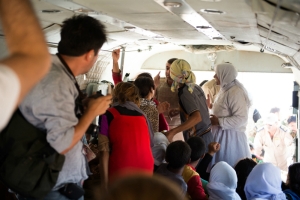
Refugees board an Iraqi Army helicopter atop Mount Sinjar on Aug. 12, 2014. Minutes later, the helicopter would crash as it attempted to take off. (ADAM MIRANI)
Since then, dozens of American, Iraqi and other flights have dropped food, water and other supplies in an effort to provide refugees with the bare minimum needed to survive. On Aug. 9, American F/A-18 planes and armed drones began bombing ISIS positions around Mount Sinjar, allowing for more effective air drops and helicopter rescue missions.
After the helicopter crash, Mirani decided to stay close to the Peshmerga. As night fell, he climbed into a pickup truck and tried to get some sleep.
"All of a sudden, the Pesh general was telling everyone to get up quickly and be ready to move. Then they actually drove away with all the Pesh," Mirani said. "I thought some kind of attack was happening against positions in the mountains and wasn't really sure what to do if ISIS all of a sudden showed up."
But soon the Peshmerga returned, with some new company.
"I almost immediately knew they were U.S. military as they were speaking American accents in English, and had night vision and heavy gear on," Mirani said. "A minute later I saw an American flag on one of their shoulders in the moonlight."
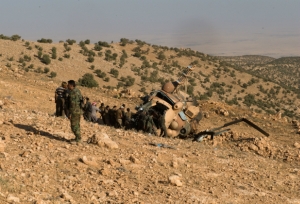 That day, the Pentagon had announced that 130 members of the Marines and Special Operations forces would deploy to northern Iraq. Despite the limited scope of their ostensible mission - to advise the Kurds and assess the humanitarian situation on Mount Sinjar - the added deployment represented a further escalation of the U.S. military's fight against ISIS, which has been welcomed by the Iraqi and Kurdish governments.
That day, the Pentagon had announced that 130 members of the Marines and Special Operations forces would deploy to northern Iraq. Despite the limited scope of their ostensible mission - to advise the Kurds and assess the humanitarian situation on Mount Sinjar - the added deployment represented a further escalation of the U.S. military's fight against ISIS, which has been welcomed by the Iraqi and Kurdish governments.
Mirani said he was warned by the Peshmerga not to approach the Americans. But he wasn't going to just sit and watch: he was stranded on a mountain surrounded by terrorists, and U.S. Special Forces had just made a cinematic nighttime entrance by parachute.
"I walked up and said, 'Hey man, how's it going?'" Mirani said.
"They were like, 'You speak really good English.'"
"Yeah, I'm Canadian."
"Oh, we're looking for you," the soldier said, according to Mirani. (It's likely that the Canadian government, following diplomatic protocol, notified the U.S. government that one of its citizens was stranded.) "Come with me."
Help from Syrian Kurdish fighters
On the morning of Aug. 13, Mirani helped translate for the Special Forces soldiers, interviewing other people on the mountain and assisting with what appeared to be both a humanitarian and reconnaissance mission. To plan a potential large-scale rescue operation, the soldiers needed to figure out how many people needed rescuing and the extent of the threat around the mountain.
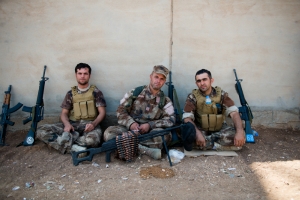
Kurdish soldiers guarding Mount Sinjar pose with their weapons. (ADAM MIRANI)
"It's an amazing unit, the Special Forces, they are completely connected with everything around them – the fighter jets flying above, the drones, command units somewhere else," Mirani said. "They monitor all activity, it seemed, all around the mountain."
Mirani saw the American soldiers consulting not only with the refugees and the Peshmerga, but also with fighters wearing the insignia of the YPG, a Syrian Kurdish militant group closely affiliated with the Kurdistan Workers' Party (PKK).
Those organizations have an uneasy relationship with the Kurdistan Regional Government's (KRG) ruling parties - and with the U.S. and Turkey, which officially consider the PKK and its affiliates a terrorist organization - but on a practical level, in the fight against ISIS, the erstwhile Kurdish pariahs have become useful allies. After the fall of Sinjar, YPG units formed a vanguard to launch a counter-attack – including taking back the Rabiaa border crossing – and PKK fighters have also helped attack insurgents along the eastern half of Kurdistan's 1,000 kilometer border with ISIS.
The YPG fighters on Mount Sinjar did not appear to be working closely with the Peshmerga, Mirani said, but they have been largely responsible for helping Yezidis evacuate the mountain by foot, leading them down safe routes into Kurdish-controlled territory in Syria, from which they have re-entered Iraqi Kurdistan.
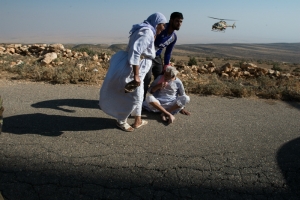
Refugees on Mount Sinjar wait for a rescue helicopter to land. (ADAM MIRANI)
The YPG's rescue efforts seem to have helped bring thousands of people to safety. At the end of the day surveying the mountain, one Special Forces soldier told Mirani they estimated only about 2,000 people were still stranded.
Around noon on Aug. 13, an Iraqi helicopter came for another rescue mission, but refugees mobbed the landing zone, forcing the pilot to abandon the mission. The helicopter dropped down low enough to drop off supplies and then turned back to Kurdistan.
Outraged and desperate, the refugees marched toward a Peshmerga outpost to protest.
Around midnight, the U.S. Special Forces loaded up, their reconnaissance mission completed, and took Mirani back with them to the military side of the airport in Erbil.






